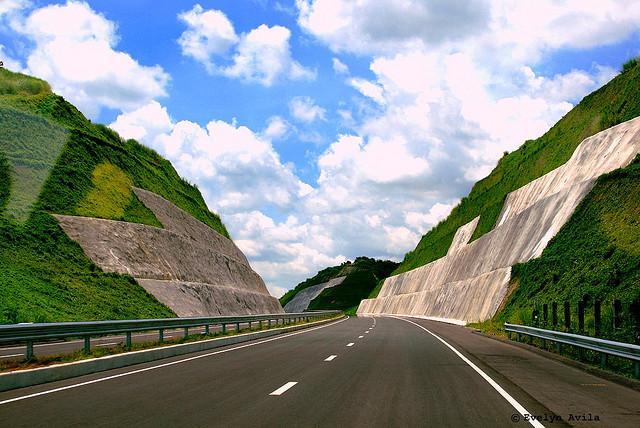
The Subic-Clark-Tarlac Expressway (SCTEx) is a 94-kilometre (58 mi) four-lane expressway north of Manila, in the Philippines. Its southern terminus is at the Subic Bay Freeport Zone in Zambales passes through the Clark Freeport Zone in two interchanges: Clark North and Clark South. The expressway is linked to the North Luzon Expressway through the Mabalacat Interchange, and its northern terminus is at Brgy. Amucao in Tarlac City, Tarlac.
Construction
The Subic-Clark-Tarlac Expressway or SCTEx Project was initiated under the administration of former President Joseph Estrada with an original project cost of P15.73 billion. Construction was started in 2005 under the government of President Gloria Macapagal-Arroyo. It is the longest tollway in the Philippines that connects Subic, Clark and Tarlac. During the year 2007 the project was delayed but before 2008, construction resumed. It was completed with a project cost of P32 billion.
Soft Opening
On March 18, 2008 at exactly 1 PM, President Gloria Macapagal-Arroyo opened the Subic - Clark segment of the Subic-Clark-Tarlac Expressway for the Holy Week Dry Run. This helped the motorists celebrating Holy Week in Zambales and Bataan. The Dry Run was free and for Class 1 Vehicles Only. The Holy Week Dry Run was from March 18: 1 PM to 5:30 PM and March 19 to 24: 5:30 AM to 5:30 PM because the expressway had no lights yet.
Subic - Clark Segment Opening
On April 28, 2008 at exactly 12 noon, BCDA Announced the Subic - Clark Segment of Subic-Clark-Tarlac Expressway was now open to all vehicles. BCDA said that travel time from Manila to Subic via North Luzon Expressway would now only take 1 Hour and 40 Minutes while the travel time from Clark to Subic would only take 40 Minutes.
Clark - Tarlac Segment Opening
On July 25, 2008 12:01 am, the BCDA announced the opening of the Clark-Tarlac Segment of the Subic-Clark-Tarlac Expressway. Travel time from Clark to Tarlac was reduced to only 25 Minutes and to travel the entire length of the SCTEx would only take 1 Hour and 5mins. or 65 Minutes. At the same time, the travel time from Manila to Tarlac via NLEx and the SCTEx would only take 1 Hour and 25 Minutes.
Development
The expressway is part of the Bases Conversion Development Authority's Subic-Clark-Tarlac Expressway Project or SCTEP, which aims to connect the ecozones of Subic and Clark. The joint-venture of First Philippine Infrastructure Development Corporation, Tollways Management Corporation and Egis Projects, the same concessionaires of the North Luzon Expressway, will handle all the operations and maintenance of the expressway. First Philippine Infrastructure Development Corporation is a subsidiary of First Philippine Holdings, a holding company under the Lopez Group of Companies with core investments in power and tollways, and strategic initiatives in property and manufacturing. The four-lane divided highway is divided into two major sections. The first section, the Subic-Clark section is 50.5 kilometers long; the Clark-Tarlac section measures 43.27 kilometers long. Undertaking the construction for the first section are the Kajima-Obayashi-JFE Engineering-Mitsubishi (KOJM) Joint Venture and the second section under Hazama-Taisei-Nippon Steel (HTN) Joint Venture.
The total cost for the construction of the expressway is Php 27.405 billion. It was sourced through a loan from the Japan Bank for International Cooperation (JBIC) amounting to ¥41.93 billion or Php23.06 billion-with an interest rate of 0.95% per annum. The project, supposed to be completed by December 2007, was delayed due to right-of-way issues and slippage fixes.
P22.63 billion of the total project cost represents direct costs such as expenses incurred for the construction of the SCTEX. The indirect costs of P3.34 billion include land acquisition, consultancy services, project management expenses and taxes and duties. Financing costs of P1.23 billion include the Department of Finance guarantee fee and JBIC loan interest during the construction period. Toll Fees are approved by the Toll Regulatory Board (TRB).
Plans
- Renaming of the Subic-Tipo Expressway, SCTEx, TPLEx, and TNAEx to North Luzon West Expressway – After the three tollways namely the SCTEx, TPLEx, and the TNAEx have been all operational, plans to rename the these three tollways together with the Subic-Tipo Expressway as the North Luzon West Expressway was already approved mainly because it traverses northwards via the western side of the North Luzon region and to make it easier to distinguish together with its counterpart the North Luzon East Expressway which traverses northwards via the eastern side of the North Luzon region. This project is under the "Public Private Partnership Program" of President Benigno Aquino III.
- Extension to La Union – President Gloria Macapagal-Arroyo plans to extend the SCTEx to Rosario, La Union from Tarlac City via the Tarlac-Pangasinan-La Union Expressway which is the Phase 2 extension of the North Luzon Expressway and the Phase 2 of the North Luzon West Expressway. The Clark-Tarlac segment of SCTEx is classed as the extension of Phase 1 of the North Luzon Expressway and also the Phase 1 of the North Luzon West Expressway. Construction began two years ago and to be completed by 2013.
- Extension to Aurora – Senator Edgardo Angara plans to extend the SCTEx to Aurora from Tarlac City via Tarlac-Nueva Ecija-Aurora Expressway the Phase 3 Extension of North Luzon Expressway and the Phase 3 of the North Luzon West Expressway because the Clark-Tarlac Segment of SCTEx is the Extension Phase 1 of North Luzon Expressway and also the Phase 1 of the North Luzon West Expressway.










